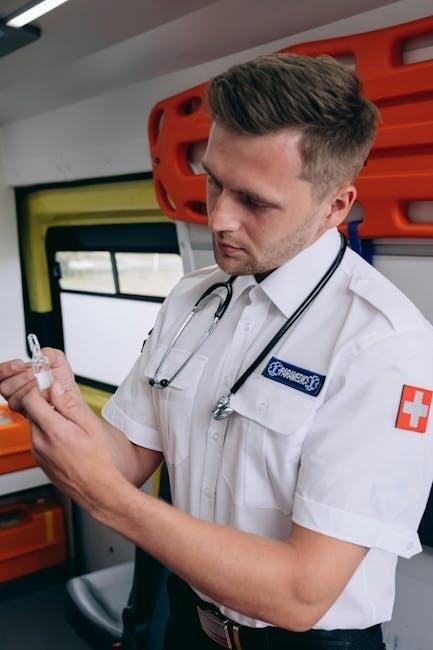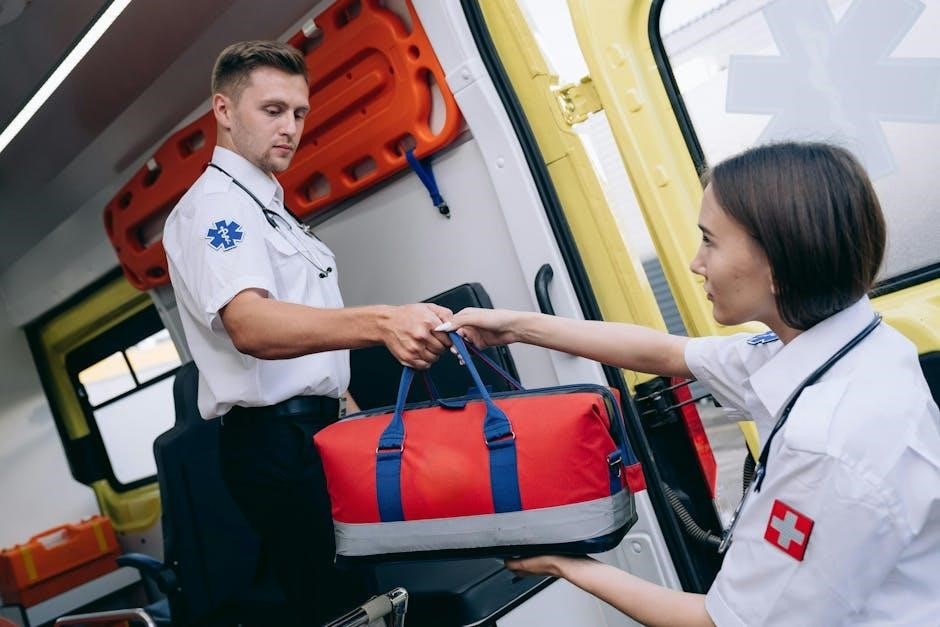first aid step 1 2023 pdf
The First Aid Step 1 2023 PDF is a comprehensive guide providing updated first aid techniques and protocols for 2023. It includes step-by-step instructions, essential for medical students and professionals, ensuring quick and effective emergency responses.
What is First Aid Step 1?
First Aid Step 1 refers to the initial, critical actions taken to assess and address an emergency situation. It involves evaluating the scene for safety, checking the person’s responsiveness, and providing immediate care until professional help arrives. This step is crucial for preventing further harm and stabilizing the individual. According to the American Red Cross, it includes tasks like calling 911, opening the airway, and starting CPR if necessary. The First Aid Step 1 2023 PDF outlines these procedures in detail, ensuring users are well-prepared to handle emergencies effectively. It serves as a foundational guide for both professionals and individuals seeking to master life-saving skills.
Importance of First Aid Training in 2023
First aid training is essential in 2023 as it equips individuals with the skills to respond confidently during emergencies. According to the American Red Cross, immediate intervention can significantly improve outcomes, especially in cases like cardiac arrest or severe injuries. Updated protocols in the First Aid Step 1 2023 PDF emphasize evidence-based practices, ensuring users are prepared for modern emergency scenarios. Training not only saves lives but also reduces the risk of complications, empowering individuals to act decisively. With rising awareness of medical emergencies, first aid certification has become a vital skill for everyone, fostering safer communities and better healthcare outcomes.

Step-by-Step Guide to First Aid
First aid involves assessing the situation, checking for responsiveness, and providing immediate care. It’s crucial to follow updated protocols, like those in the 2023 PDF, to ensure effective assistance until professional help arrives.
Step 1: Assess the Situation
Assessing the situation is the first and most critical step in providing first aid. Ensure the area is safe for both the victim and the responder. Check for potential hazards like broken glass, fire, or falling objects. Next, quickly evaluate the severity of the injury or illness. Look for visible signs such as bleeding, burns, or difficulty breathing. Determine if the situation requires immediate professional help. Stay calm and focused to make accurate decisions. According to the 2023 First Aid Step 1 PDF, this initial assessment guides the next steps in care. Always prioritize safety and act swiftly to prevent further harm. Proper evaluation ensures effective and timely assistance.
Step 2: Check for Responsiveness
After assessing the situation, the next step is to check if the person is responsive. Gently tap the person’s shoulder and ask, “Are you okay?” Loudly shout to stimulate a response. If the person does not react, they are unresponsive. According to the 2023 First Aid Step 1 PDF, this step is crucial to determine the level of care needed. If unresponsive, immediately call 911 or your local emergency number. Do not leave the person alone. Next, check for breathing by listening for breath sounds and feeling for air on your cheek. Simultaneously, check for a pulse on the neck. If there is no breathing or pulse, begin CPR. This step ensures timely intervention for life-threatening conditions. Always follow the latest guidelines for the best outcomes.
Step 3: Call 911 or Local Emergency Number
Once unresponsiveness is confirmed, immediately dial 911 or your local emergency number. According to the 2023 First Aid Step 1 PDF, timely emergency services notification is critical. Stay calm and provide clear information, such as location and the situation, to dispatchers. If possible, send someone to meet paramedics. Do not leave the person unattended until help arrives. Ensure the line remains open for any further instructions. Prompt action saves lives and improves outcomes. Always follow the latest emergency response guidelines for effective assistance. This step is vital in securing professional medical help quickly, ensuring the best possible care for the individual in need.
Step 4: Provide Care Until Help Arrives
After calling emergency services, begin administering care following the 2023 First Aid Step 1 PDF guidelines. If the person is unresponsive and not breathing, start CPR with chest compressions and rescue breaths. For injuries like burns or bleeding, apply appropriate first aid techniques. Keep the individual calm and comfortable, avoiding unnecessary movement. Loosen tight clothing and cover them to prevent shock. Do not administer medications unless trained. Continuously monitor their condition and be prepared to provide updates to emergency responders upon arrival. Providing care until professional help arrives significantly enhances recovery chances and reduces complications, emphasizing the importance of proper first aid training. Stay attentive and follow the latest protocols to ensure effective assistance;

First Aid for Specific Injuries
Learn essential techniques for treating burns, frostbite, and bleeding from the 2023 First Aid Step 1 PDF. Immediate care can prevent further harm and promote recovery.
First Aid for Burns
Proper first aid for burns is crucial to prevent further damage and promote healing. For minor burns, cool the area with cool water for 10-15 minutes. Do not use ice or ice water. Remove any tight clothing or jewelry near the burn. Cover the burn with a non-stick, sterile bandage or a clean cloth. For severe burns (charred skin, blisters), do not remove clothing stuck to the burn. Keep the affected limb elevated and seek immediate medical attention. Avoid applying butter, oil, or ointments, as these can worsen the injury. Always follow updated 2023 first aid guidelines for optimal care.
First Aid for Frostbite
When treating frostbite, prioritize moving the individual to a warm environment to prevent further exposure. Gently remove wet clothing and jewelry from the affected area. Immerse the frostbitten skin in warm (not hot) water for 15-30 minutes to rewarm. Avoid direct heat, rubbing, or breaking blisters, as this can cause additional damage. Keep the area clean and dry. If symptoms persist or worsen, seek immediate medical attention; Severe frostbite may require professional care to prevent tissue loss. Always follow the latest 2023 first aid guidelines for frostbite treatment to ensure the best possible outcomes and minimize long-term damage.
First Aid for Bleeding
When managing bleeding, prioritize putting on gloves to protect yourself and the injured person. Apply direct pressure using a clean cloth or bandage to the wound, elevating the injured limb above heart level if possible. Avoid using a tourniquet unless absolutely necessary and you are trained to do so. If bleeding doesn’t stop with direct pressure, seek immediate medical attention. For severe bleeding, call 911 or your local emergency number. Keep the person calm and comfortable until help arrives. Always follow the latest 2023 first aid guidelines for bleeding control to ensure effective treatment and prevent complications.

Cardiac Emergencies
Cardiac emergencies require immediate action to save lives. Recognize symptoms like chest pain, stay calm, and activate emergency services promptly for optimal outcomes.
CPR Step-by-Step Instructions
Start by assessing the scene for safety and checking the person’s responsiveness. Call 911 or your local emergency number immediately. Place the person on their back on a firm, flat surface. Position your hands: one on top of the other, placing the heel of one hand on the center of the chest. Perform chest compressions at a rate of 100-120 per minute, allowing the chest to fully recoil between compressions. If trained, give rescue breaths after every 30 compressions. Use an AED if available, following its voice prompts. Continue CPR until emergency medical personnel arrive. Minimize interruptions to chest compressions to maximize effectiveness.
Using an AED (Automated External Defibrillator)
Turn on the AED and follow its voice prompts. Expose the person’s chest and wipe it dry. Attach the pads to the bare chest as shown on the AED’s diagram. Analyze the heart rhythm by pressing the button or as instructed. If a shock is advised, deliver it promptly. Ensure no one is touching the person during the shock. Resume CPR with 30 chest compressions after the shock. Continue this cycle until emergency responders arrive. Always follow the AED’s specific instructions. Do not delay compressions to use the device. Proper AED use can significantly improve survival chances in cardiac emergencies.
Hands-Only CPR
Hands-Only CPR is a lifesaving technique for cardiac arrest situations. If a person collapses and is unresponsive, call 911 immediately. Place the heel of one hand on the center of their chest, cover it with your other hand, and interlock your fingers. Keep your arms straight and elbows locked. Push down to the beat of “Stayin’ Alive” or another song with a tempo of 100-120 beats per minute. Depth should be 2-3 inches into the chest. Avoid stopping compressions until emergency responders arrive. This method eliminates the need for rescue breaths, making it easier for untrained bystanders to act confidently. It’s crucial for increasing survival rates in cardiac emergencies, as emphasized in 2023 first aid guidelines.

First Aid for Medical Conditions
This section covers essential first aid techniques for common medical emergencies, such as seizures, allergic reactions, and asthma attacks, ensuring timely and effective care.
First Aid for Seizures
When assisting someone experiencing a seizure, ensure their safety by clearing the area of harmful objects. Do not restrict their movement or force anything into their mouth. Gently turn them onto their side to maintain an open airway. After the seizure ends, provide reassurance and stay with the person until they recover. If the seizure lasts more than 5 minutes, call emergency services immediately. The First Aid Step 1 2023 PDF outlines these steps clearly, emphasizing the importance of monitoring and providing a safe environment. Always follow updated guidelines to ensure effective care during such medical emergencies.
First Aid for Allergic Reactions
An allergic reaction occurs when the body’s immune system overreacts to a harmless substance. Symptoms can range from mild, such as hives or itching, to severe, like swelling of the airways or anaphylaxis. Immediate action is crucial. If the person carries an epinephrine auto-injector, such as an EpiPen, administer it as directed. Call 911 or your local emergency number if the reaction is severe or worsening. Loosen tight clothing around the neck and keep the person calm. Do not give oral medications if they are unconscious or having difficulty breathing. Monitor their condition until medical help arrives. Follow the latest guidelines from the First Aid Step 1 2023 PDF to ensure proper care during allergic emergencies.
First Aid for Asthma Attacks
An asthma attack occurs when airway muscles tighten, causing difficulty breathing. Symptoms include wheezing, coughing, shortness of breath, and chest tightness. Stay calm and help the person sit upright. If they have an inhaler, assist them in using it as directed. Do not lie them down. If symptoms worsen or no improvement occurs after two puffs, seek emergency help. Monitor their breathing and reassure them until medical assistance arrives. Follow the latest guidelines in the First Aid Step 1 2023 PDF for managing asthma emergencies effectively. Always prioritize calling 911 if the person experiences severe distress or stops breathing.

First Aid for Trauma
Ensure scene safety, control bleeding with direct pressure, and immobilize injuries. Monitor vital signs and keep the person calm. Use splints for fractures and avoid moving unnecessarily. Always follow the First Aid Step 1 2023 PDF guidelines to stabilize trauma patients effectively until professional help arrives.
First Aid for Head Injuries
When dealing with head injuries, assess the situation carefully and ensure the scene is safe. Check the person’s responsiveness and control any bleeding with clean gauze or cloth. Immobilize the head and neck to prevent further injury. Monitor vital signs and avoid moving the person unnecessarily. If the person is unconscious, place them in the recovery position. Do not administer pain medication. Seek immediate medical attention if there is a loss of consciousness, confusion, or severe symptoms like vomiting or seizures. Follow the First Aid Step 1 2023 PDF guidelines to provide appropriate care until professional help arrives.
First Aid for Sprains and Strains
When dealing with sprains and strains, prioritize stopping activity to prevent further injury. Apply the RICE method: Rest, Ice, Compression, and Elevation. Use ice for 15-20 minutes every hour to reduce swelling. Apply a compression bandage and elevate the injured limb above heart level. For pain management, over-the-counter medications like ibuprofen can be used if appropriate. Immobilize the area with a brace or splint to avoid movement. Monitor for severe symptoms such as numbness or inability to move the limb, which may require medical attention. Follow the guidelines in the First Aid Step 1 2023 PDF for detailed instructions on managing these injuries effectively.

First Aid for Broken Bones
For broken bones, prioritize immobilizing the affected area to prevent further injury. Use a splint or sling to keep the limb stable and avoid moving the injured person unless necessary. Apply ice to reduce swelling but avoid direct contact with the skin. Check for deformities, swelling, or bruising, and gently immobilize the area with a padded splint or materials like cardboard. Do not attempt to straighten or move the bone. If the break is open (bone protruding through the skin), cover the wound with a sterile dressing to prevent infection. Seek immediate medical attention for proper treatment. The First Aid Step 1 2023 PDF provides detailed guidance on managing fractures effectively in emergency situations.

First Aid for Environmental Emergencies
Environmental emergencies like heatstroke and hypothermia require immediate action. Assess the situation, move the person to safety, and call for help. Use resources like the First Aid Step 1 2023 PDF to stay updated on 2023 guidelines for such scenarios.
Ensure proper care until professional help arrives, focusing on stabilization and comfort. Environmental emergencies demand quick, informed responses to prevent worsening conditions.
First Aid for Heatstroke
Heatstroke is a severe medical emergency requiring immediate attention. It occurs when the body overheats, often due to prolonged exposure to high temperatures. Symptoms include high body temperature, confusion, slurred speech, and loss of consciousness. If heatstroke is suspected, move the person to a cooler environment and call 911 or the local emergency number. Remove excess clothing and use cool, wet cloths or ice packs to lower body temperature. Never apply ice directly to the skin. Encourage hydration with small sips of cool water if the person is conscious. Monitor temperature closely and continue cooling efforts until medical help arrives. Always prioritize rapid action to prevent complications. Stay updated with 2023 first aid guidelines for effective care.
First Aid for Hypothermia
Hypothermia occurs when body temperature drops below 95°F (35°C), requiring immediate attention. Symptoms include shivering, confusion, drowsiness, and slow breathing. If suspected, call 911 or the local emergency number and move the person to a warm, dry place. Remove wet clothing and gently wrap them in blankets or warm clothing to retain body heat. Avoid direct heat sources, as they can cause sudden temperature changes. Offer small sips of warm, non-caffeinated liquids if the person is conscious. Monitor their temperature closely and avoid moving them excessively. Stay updated with 2023 first aid guidelines to ensure proper care and prevent complications. Acting quickly is crucial to help restore normal body temperature safely.

Resources and References
Key resources include the 2023 First Aid Manual by American Red Cross and the First Aid for the USMLE Step 1 2023 PDF, offering updated guidelines and step-by-step instructions.

2023 First Aid Manual by American Red Cross
The 2023 First Aid Manual by the American Red Cross is a trusted resource for first aid training, providing updated protocols and guidelines. It includes step-by-step instructions for emergencies like burns, frostbite, and cardiac issues. The manual emphasizes the importance of quick action and proper techniques to save lives. Updated in collaboration with the American Heart Association, it reflects the latest research and best practices. Topics range from basic care to advanced life-saving measures, making it essential for both professionals and the general public. Available in print and digital formats, this manual ensures accessibility for all. It remains a cornerstone for first aid education and emergency preparedness in 2023.
First Aid for the USMLE Step 1 2023 PDF
First Aid for the USMLE Step 1 2023 PDF is a widely used study guide for medical students preparing for the United States Medical Licensing Examination (USMLE) Step 1. Known for its concise and high-yield content, it helps students identify and focus on key topics frequently tested on the exam. The 2023 edition includes updated clinical vignettes, pharmacology, and pathophysiology sections, reflecting the latest medical knowledge. Organized into easy-to-review sections, it emphasizes essential facts and mnemonics, making it a reliable resource for effective studying. The guide complements traditional textbooks by providing a focused approach, ensuring students cover all necessary material efficiently as they prepare for this critical exam.
The First Aid Step 1 2023 PDF is a vital resource, providing essential first aid training and exam preparation. It offers updated, practical advice, ensuring readiness for emergencies and academic success.
Why First Aid Training is Essential
First aid training is crucial for equipping individuals with the skills to respond effectively in emergencies. It empowers people to act confidently, reducing panic and preventing situations from worsening. Updated guidelines, like those in the 2023 First Aid Step 1 PDF, ensure that practices align with current medical standards. Proper first aid can save lives, minimize recovery time, and prevent long-term damage. It also fosters a culture of safety and awareness, enabling bystanders to make a significant difference. Whether for burns, bleeding, or cardiac arrests, immediate care can be lifesaving. Investing in first aid training not only protects individuals but also strengthens community resilience and preparedness.
Stay Updated with 2023 First Aid Guidelines
Staying updated with the 2023 First Aid Guidelines is vital for providing effective and safe care in emergencies. The First Aid Step 1 2023 PDF offers the latest protocols, ensuring practices align with current medical standards. Updated guidelines address new techniques, such as revised CPR protocols and enhanced care for burns and bleeding. These changes reflect advancements in research and clinical practice, emphasizing evidence-based approaches. Regular updates ensure first responders and individuals can deliver care confidently, reducing complications and improving outcomes. By following the 2023 guidelines, users can stay informed about critical changes, such as the use of automated external defibrillators (AEDs) and hands-only CPR. This resource is essential for anyone seeking to maintain proficiency in first aid.